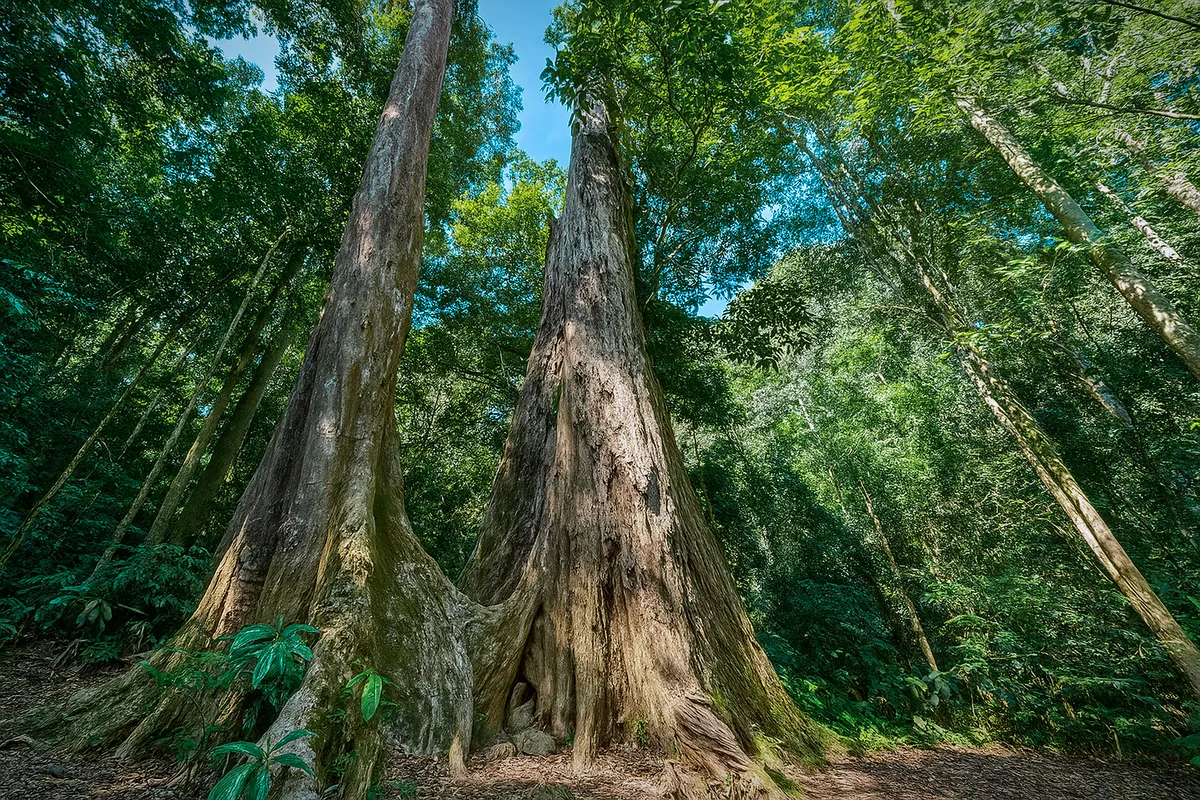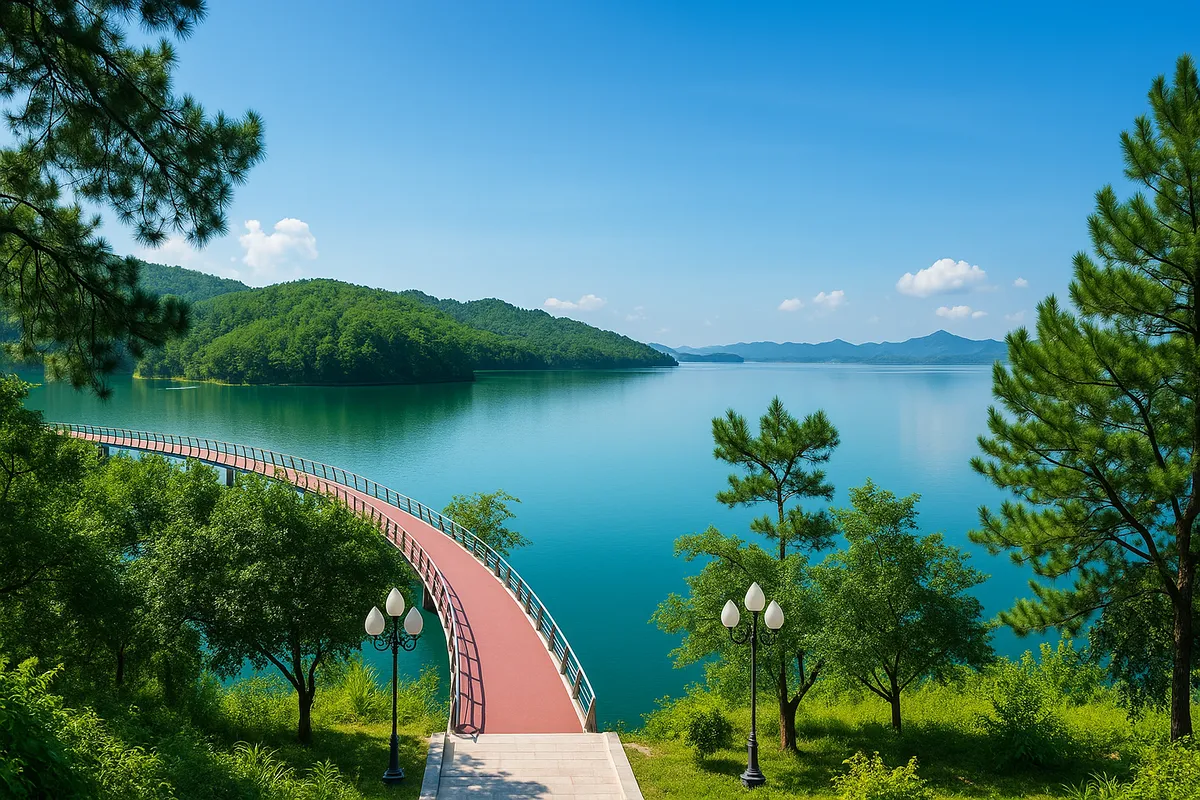Khu du lịch Vườn quốc gia Cúc Phương có gì hấp dẫn
- Thứ ba, 17/06/2025, 10:03 (GMT+7)
Khu du lịch Vườn quốc gia Cúc Phương có gì hấp dẫn
Khu du lịch Vườn quốc gia Cúc Phương mở ra như một thế giới cổ tích chưa kể hết. Không ồn ào, không vội vã, không phô trương ánh đèn hay lối mòn du lịch quen thuộc, nơi đây mang đến cảm giác như bước vào một giấc mơ xanh mát, nơi rừng già trở thành bạn đồng hành, và thiên nhiên thì thầm bằng thứ ngôn ngữ rất đỗi dịu dàng.
Vườn quốc gia Cúc Phương thuộc địa phận ba tỉnh Ninh Bình, Hòa Bình và Thanh Hóa, là vườn quốc gia đầu tiên được thành lập tại Việt Nam từ năm 1962. Với diện tích hơn hai mươi hai nghìn hecta, khu rừng nguyên sinh này là nơi trú ngụ của hàng ngàn loài động thực vật quý hiếm, có nhiều loài được phát hiện lần đầu tiên tại đây và mang tên Cúc Phương để vinh danh.
Cảnh quan nơi đây là một bản hòa tấu của đá, rừng và thời gian. Rừng xanh ngắt kéo dài đến tận chân trời, cây cổ thụ hàng trăm năm tuổi vươn cao như chạm vào mây, rễ cây ngoằn ngoèo như những mạch máu lớn lộ ra trên nền đất, phủ đầy rêu xanh và dấu vết của những cơn mưa đã qua. Ánh nắng xuyên qua tán lá, tạo nên những vệt sáng mờ ảo, nơi từng hạt bụi cũng trở nên lung linh như kim tuyến lơ lửng trong không khí.
Rừng không chỉ là cây, là đá. Rừng còn là ký ức. Bên trong lòng núi đá vôi là những hang động cổ: Hang Người Xưa, hang Con Moong, hang Thủy Tiên. Đây là nơi các nhà khảo cổ tìm thấy dấu tích của người tiền sử, sống cách đây hàng ngàn năm, với công cụ lao động sơ khai và tro tàn từ bếp lửa cổ xưa. Các lớp trầm tích nối tiếp nhau như những chương sách về buổi bình minh của loài người, không nói thành lời nhưng vang vọng bằng khí chất thiêng liêng. Trong số đó, hang Con Moong chứa đến mười lớp văn hóa khác nhau, ghi dấu một hành trình sinh tồn bền bỉ trong bóng tối lạnh lẽo và ẩm ướt.
Về mặt địa chất, nơi đây từng là đáy biển hàng trăm triệu năm trước. Những hóa thạch sinh vật biển vẫn được tìm thấy trong các khối đá vôi. Có thể nói, đi xuyên qua Cúc Phương là đi qua cả một thời gian trầm tích của Trái đất. Ngay cả một loài cá đặc biệt không có mắt, sống trong hang tối, cũng được các nhà khoa học phát hiện và đặt tên theo vùng đất này, như một dấu ấn độc đáo ít người biết.
Không chỉ lưu giữ những di sản cổ xưa, Cúc Phương còn là ngôi nhà hiện tại của nhiều loài linh trưởng quý hiếm như voọc mông trắng, voọc vàng, voọc đầu đen. Trong rừng sâu có các trung tâm cứu hộ động vật hoang dã như nơi hồi sinh thầm lặng cho những sinh linh từng bị đe dọa. Không phải là nơi trưng bày để ngắm nhìn, mà là chốn ẩn mình của sự kiên nhẫn và tận tụy, nơi con người lặng lẽ trả lại sự sống cho những sinh vật bị lãng quên.
Khi rừng lên tiếng, đó là tiếng chim hót trong vắt giữa sớm mai, là tiếng lá khô xào xạc dưới gót chân, là âm vang của gió trượt qua những khe đá cổ. Và đôi khi, đó cũng là sự im lặng đầy ý nghĩa, khiến người ta phải dừng lại, lắng nghe chính mình giữa một không gian không còn khái niệm về thời gian.
Một trong những khoảnh khắc đặc biệt nhất ở đây là mùa bướm vào khoảng tháng tư đến tháng năm. Hàng chục nghìn con bướm trắng, vàng, xanh lam… cùng tung bay trong nắng khiến khung cảnh như bước ra từ một bộ phim điện ảnh. Đứng giữa rừng, nhìn bướm bay dày đặc đến mức che mờ cả lối đi, lòng người như dịu lại, nhẹ tênh và rỗng rang như chiếc lá vừa buông khỏi cành.
Từ Hà Nội, hành trình đến Cúc Phương mất khoảng ba giờ di chuyển. Có thể đi xe khách đến Nho Quan rồi tiếp tục bằng xe ôm hoặc taxi. Nhiều người chọn cách thuê xe máy để chủ động đi sâu vào rừng, men theo những cung đường nhỏ uốn lượn quanh triền núi, nơi một bên là rừng già, bên kia là ruộng bậc thang hoặc sông suối len lỏi dưới thung sâu.
Thời điểm lý tưởng nhất để du lịch Cúc Phương là từ tháng mười một đến tháng ba năm sau. Trời hanh, đường khô, cảnh sắc dịu nhẹ, thuận lợi cho việc trekking, chụp ảnh, dừng chân nghỉ giữa rừng và cắm trại. Tuy nhiên, mùa mưa từ tháng tư đến tháng tám cũng có nét quyến rũ riêng, đặc biệt nếu muốn săn ảnh về đời sống động thực vật sinh động sau mưa. Cần chuẩn bị kỹ lưỡng vì khi ấy, vắt và muỗi khá nhiều, đường rừng dễ trơn trượt. Một đôi giày chống nước, quần dài bó gấu, mũ rộng vành và áo khoác nhẹ là hành trang không thể thiếu.
Ẩm thực nơi rừng già giản dị nhưng đủ sức khiến người ta nhớ mãi. Món xôi ngũ sắc dẻo quánh, cơm lam nướng trong ống tre, măng rừng luộc chấm muối vừng, thịt lợn bản gác bếp thơm lừng vị khói. Những món ăn không cầu kỳ nhưng mang đầy tinh thần đất rừng, như thể mỗi miếng ăn là một phần linh hồn nơi đây đang hoà tan vào vị giác.
Một số điều thú vị mà ít người biết về Cúc Phương chính là loài lan không mùi nở về đêm, chỉ tồn tại trong vài giờ rồi tàn lụi, như một chớp mắt của thiên nhiên. Hay việc có những cây cổ thụ khi gõ vào sẽ phát ra âm thanh rỗng như tiếng trống, từng được người bản địa dùng để báo động trong chiến tranh. Cũng có truyền thuyết rằng đỉnh Mây Bạc đôi khi giấu cả mặt trời trong mù sương đặc quánh, khiến không gian trở nên huyền ảo như tranh thủy mặc suốt cả ngày dài.
Kết thúc một ngày ở Cúc Phương không phải là lúc rời rừng, mà là khoảnh khắc lòng người còn đọng lại tiếng lá rơi. Có một câu nói từng được truyền miệng giữa những người trẻ yêu thiên nhiên rằng: Giữa rừng già, trái tim tìm về nhịp đập nguyên thủy. Có lẽ, chẳng cần thêm lời quảng bá nào, chỉ một lần đặt chân đến đây, đứng giữa cây rừng cao ngất và lắng nghe hơi thở của đất, ai cũng sẽ hiểu vì sao Cúc Phương xứng đáng được trân trọng, gìn giữ và yêu thương như một phần ký ức chung của đất nước này.

 CHECKIN.VN
CHECKIN.VN








Chia sẻ trên